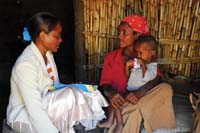
The in-depth interview is another important method of data collection. This technique can be used when you want to explore individual beliefs, practices, experiences and attitudes in greater detail. It is usually conducted as a direct personal interview with one person - a single respondent. Using in-depth interviews as a health professional, you can discover an individual's motivations, beliefs, attitudes and feelings about health and illness. For example, you may want to explore a mother's attitudes to - and use of - contraception.
It is a good idea to use open-ended questions to encourage the respondent to talk, rather than closed questions that just require a yes or no answer.
An in-depth interview can take around 30–90 minutes. The box below lists the steps you should take when conducting an in-depth interview.

Perhaps you could practise inventing open-ended questions. Try it out on your family and friends until it becomes easy to do. A closed question goes like this: Do you like vegetables? The person can only really say yes or no. An open question goes like this: Tell me something about how vegetables fit into your diet? Then the person can start talking about vegetables much more — and you will get a lot more information.
A good time to do an in-depth interview is when the subject matter is sensitive; for example, gathering data from women regarding their feelings about sexuality and family planning, or if the woman has had an abortion. This is a useful technique when you need to explore an individual's experiences, beliefs and attitudes in greater detail.